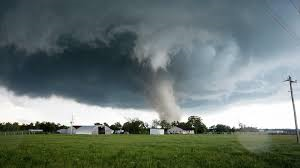Tornadoes are nature’s most violent storms. Spawned from powerful thunderstorms, tornadoes can cause fatalities and devastate a neighborhood in seconds. In fact, last year there were 48 tornadoes recorded in Missouri and 178 tornadoes recorded in Kansas. Early spring is the time for you and your family to develop a tornado safety plan.
Before a tornado strikes, make a plan.
1. Build an emergency supply kit and make a family communication plan. A basic emergency supply kit should include the following items:
- Water, one gallon of water per person per day for at least three days, for drinking and sanitation
- Food, at least a three-day supply of non-perishable food
- Battery-powered or hand crank radio and a NOAA Weather Radio with tone alert and extra batteries for both
- Flashlight and extra batteries
- First aid kit
- Whistle to signal for help
- Dust mask to help filter contaminated air and plastic sheeting and duct tape to shelter-in-place
- Moist towelettes, garbage bags and plastic ties for personal sanitation
- Wrench or pliers to turn off utilities
- Manual can opener for food
- Local maps
- Cell phone with chargers, inverter or solar charger
2. Listen to NOAA Weather Radio or to commercial radio or television newscasts for the latest information. In any emergency, always listen to the instructions given by local emergency management officials.
3. Be alert to changing weather conditions. Look for approaching storms.
4. Look for the following danger signs:
-
- Dark, often greenish sky
- Large hail
- A large, dark, low-lying cloud (particularly if rotating)
- Loud roar, similar to a freight train.
- If you see approaching storms or any of the danger signs, be prepared to take shelter immediately.
Quick facts you should know about tornadoes:
- They may strike quickly, with little or no warning.
- They may appear nearly transparent until dust and debris are picked up or a cloud forms in the funnel.
- Some are clearly visible, while others are obscured by rain and low clouds.
- Damage paths can be as large as 1 mile wide and 50 miles long.
- They can occur in any state.
- The average tornado moves Southwest to Northeast, but tornadoes have been known to move in any direction.
- The average forward speed of a tornado is 30 mph, but may vary from stationary to 70 mph.
- They can pack whirling winds that can reach 300 mph.
- Tornadoes can accompany tropical storms and hurricanes as they move onto land.
- Waterspouts are tornadoes that form over water.
- Tornadoes are most frequently reported east of the Rocky Mountains during spring and summer months.
- Peak tornado season in the southern states is March through May; in the northern states, it is late spring through early summer.
- Tornadoes are most likely to occur between 3 pm and 9 pm, but can occur at any time.
- They generally occur along the trailing edge of a thunderstorm.
- It is not uncommon to see clear, sunlit skies behind a tornado.
Educate yourself on the difference between a Watch and a Warning.
Tornado Watch – Tornadoes are possible. Remain alert for approaching storms. Watch the sky and stay tuned to NOAA Weather Radio, commercial radio or television for information.
Tornado Warning – A tornado has been sighted or indicated by weather radar. Take shelter immediately.
Next up, Tornado Safety Part 2: What to do during and after a tornado.








